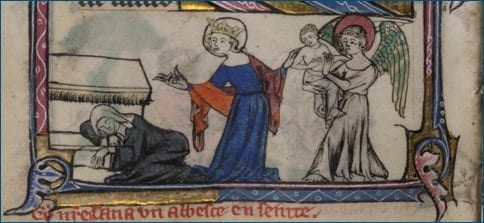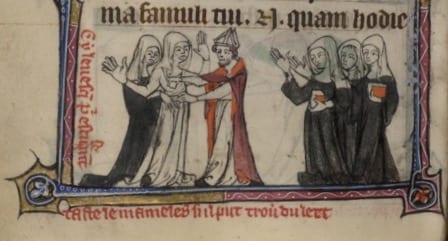Barbara Hargreaves
Durham, United Kingdom

Sometime around the year 1150, a four-year old girl was given to the Gilbertine community of nuns at Watton, England. There she grew up, took vows, and became a nun herself. It appears that she was ill-suited for the life of a religious sister, and when a group of Gilbertine brothers entered the enclosed confines of the nuns’ living space in order to do some maintenance work, the nun met the eyes of a young brother, and they started an illicit liaison. The nun’s name is unknown, but her story has survived in a late twelfth-century letter written by Aelred, abbot of Rievaulx.1
Aelred’s letter, written to a single unidentified recipient, tells that the nun conceived an infant and that her pregnancy ended with the miraculous delivery of the baby. The discovery of the nun’s pregnancy evoked a response of outrage, horror, and truly shocking violence from her sisters. His letter contains graphic details of the conditions in which the pregnant nun was held imprisoned, and descriptions too of her gravid body and its postnatal state. It is a rich and nuanced account, a redemptive narrative, written to be understood both literally and metaphorically. Aelred uses the physicality of the pregnancy itself, and the conditions of the nun’s incarceration, to bring to his reader the themes of physical and spiritual gestation and rebirth.
The pregnant nun was held chained in a small cell, stripped, beaten repeatedly and mercilessly, and fed only bread and water. Aelred describes the nun’s cell as being a “chamber within a chamber,” the cell itself located within the body of the convent and surrounded by its enclosing walls.2 She was fettered by both ankles, chained, and the chains secured through the wall of her cell to a log outside. The imagery Aelred engages here, with its focus on enclosure, is striking.
Seen through the lens of Aelred’s writing, the nun’s chains serve as an umbilical cord, attaching her to her mother convent as her own infant was attached to her. In the same way that the umbilical cord allows nourishment to flow from mother to the developing fetus, so too the nun’s chains anchored her to the fabric of the religious community, which despite the harsh treatment she received there, remained a locus for divine potentiality. Aelred’s thematic use of the notion and actuality of gestation directs his reader to understand how, at the same time as her body gestated her unborn child, the nun herself gestated within the womb of the convent, until she came eventually, through the agency of miracle, to experience a spiritual rebirth.
Aelred’s portrayal of the nun’s pregnancy, the visible manifestation of her sin, is graphic and gross. He uses the nun’s fecundity to mirror her spiritual condition, both at its sinful, fallen worst, and later on in the letter, at its best.
Already the infant moved in the womb, the milk flowed from the full breasts; her belly was so large it looked as if she would bear twins. A leaden colour surrounded her eyes, her face went white, and as soon as her breasts were emptied, they refilled with liquid. Her cell barely accommodated her now . . .3

His description of the nun’s pregnancy displays her as a seeping, corpulent mass of corrupted flesh, her pallor signifying her spiritual death. In this depiction, Aelred is using the principles of twelfth-century western-European medical theory, and applying his understanding of humoral medicine, to tell his reader about both the physical and spiritual condition of the nun. In England during Aelred’s time, new translations, or retranslations, of classical medical works, emerging mainly from Montecassino in Italy, were increasingly available in monastic libraries. Aelred’s own monastery of Rievaulx held such works.4 Humoral medicine was complex, but at its heart was the belief that balance between the four elements of nature—fire, water, air, and earth—and the four humors or bodily fluids representative of these elements—blood, phlegm, yellow bile, and black bile—was necessary for good health.5 The composition of a woman was naturally wet and cold, phlegmatic, and in health this was kept in equilibrium by the opposing hot and dry male elements and humors.6
In the case of the nun, Aelred was describing a marked imbalance of the humors; the proper moist quality of the female body had broken beyond the bounds of normality and become sodden. She was profoundly unhealthy, excessively female. Her phlegmatic overabundance was apparent in her pasty complexion, leaden-colored eyes, flabbiness, and abnormal lactation. Her abdomen was so large that it almost filled the cell, a twin pregnancy was suggested, or perhaps the possibility of polyhydramnios, excess amniotic fluid. Her breasts were already full, lactation had started antenatally. Such a profusion of milk is unusual during pregnancy, particularly in a primigravid woman, and it seems that Aelred’s description was intended to emphasize the humoral imbalance of the nun; her bodily indisposition was reflective of her significant spiritual malaise.
Having displayed the nun at her pallid and seeping worst, Aelred tells how, by divine intervention, and through the agency of a sleeping vision, the nun was led to repentance. Miraculously and without laboring, she delivered an infant which was taken away by two angelic figures. On waking, her body showed no signs of pregnancy at all but had returned completely to its pre-pregnant condition. The nuns, horrified that she might have compounded her sins by birthing and then murdering her child, examined her intimately:
They felt her belly: such slenderness had replaced the swelling that you would have thought her back was stuck to her front. They squeezed her breasts but elicited no liquid from them. Nor sparing her, they pressed harder, but expressed nothing. They ran their fingers over every joint, exploring everything, but found no sign of childbirth, no indication even of pregnancy . . . they all found the same thing: everything restored, everything proper, everything beautiful.7
The postpartum body of the nun was nearly an exact negative imprint of her antenatal form. In the same way that previously she was almost excessively pregnant, the nun was now overly not pregnant. Her abdomen, which had before been so enlarged that it nearly filled the cell and looked as though she might be bearing twins, was replaced by one so slim as to be concave. There was no evidence at all of a palpable postpartum uterus. Her eyes were bright, her color normal. Nor was there any sign of lactation; her breasts were empty. Proper humoral balance had been miraculously restored and she was now entirely healthy. Furthermore, the nun’s chains, the umbilical cord which had held her contained in her uterine cell, had fallen off. She was, in fact, freed in body and spirit, reborn. Despite the initial misgivings of her fellow nuns, Aelred judged that a miracle had occurred, that the nun was redeemed and should be welcomed back into the community of her sisters.
Aelred’s stated aim in writing his letter about the Nun of Watton was to describe the miracle which had taken place. In his account he chose to use both gestational imagery and contemporary medical science and set these within the framework of his own social and theological world. His letter told of the nun’s iniquity and eventual redemption and used the body of the nun herself to carry his narrative. She was both the subject, and the vehicle, of her own story.
Nothing more is known of her.
End Notes
- Aelred of Rievaulx, ‘De Sanctimoniali de Wattun’, Patrologia Cursus Completus: [henceforth ‘Nun of Watton’, PL]; trans. John Boswell, The Kindness of Strangers, 452-8.
- Aelred, ‘Nun of Watton’, PL 195: col. 796; trans. Boswell, 457.
- Aelred, ‘Nun of Watton’, PL 195: col. 794; trans. Boswell, 456.
- M. R. James, A Descriptive Catalogue, 50-2.
- Roy Porter, The Greatest Benefit, 9.
- Vivian Nutton, The Western Medical Tradition, 24.
- Aelred, ‘Nun of Watton’, PL 195: col. 794; trans. Boswell, 457.
Bibliography
- Aelred of Rievaulx, ‘De Sanctimoniali de Wattun’, Patrologia Cursus Completus: Series Latina, 217 Vols. ed. J. P. Migne (Paris, 1844-64), vol. 195: cols 789-796 from Corpus Christi, Cambridge, MS 139, fols 149r-51v.
- Boswell, John, The Kindness of Strangers: The Abandonment of Children in Western Europe from Late Antiquity to the Renaissance (London: Penguin, 1989).
- James, M. R., A Descriptive Catalogue of Manuscripts in the Library of Jesus College Cambridge (London: Clay and Sons, 1895).
- Porter, Roy, The Greatest Benefit to Mankind (Great Britain: Harper Collins Press, 1997).
Nutton, Vivian, ‘Roman Medicine 250 BC to AD 200’ in The Western Medical Tradition 800 Andrew Wear (Cambridge: Cambridge University Press, 1995).
BARBARA HAGREAVES is a registered nurse and midwife, who is currently studying for a PhD in medieval history at Durham University, UK. Her research is concerned with health narratives in twelfth-century hagiographical texts. She is a Freeman of the City of London.

Leave a Reply